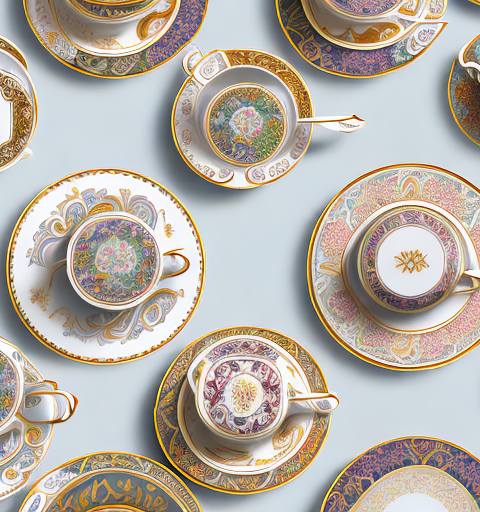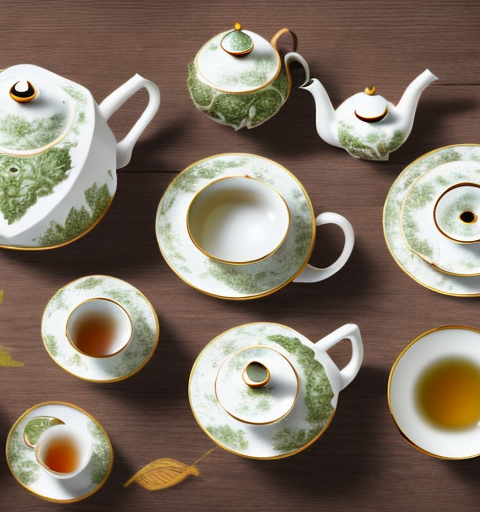Japanese tea sets are not just ordinary pieces of crockery, but artistic expressions that embody centuries of tradition and culture. Steeped in history and appreciated for their exquisite craftsmanship, these tea sets are a symbol of refinement and beauty. In this article, we will delve into the captivating world of Japanese tea sets, exploring their rich history, components, artistry, and use in tea ceremonies. We will also provide insights on collecting and caring for these remarkable treasures, as well as their modern relevance in today’s global culture.
The Rich History of Japanese Tea Sets
Tea drinking in Japan dates back to ancient times, and the tradition finds its roots in China. It was Buddhist monks who first brought tea to Japan in the 8th century, introducing it as a medicinal beverage and a means to enhance meditation practices. Over the centuries, tea drinking gained popularity among the Japanese aristocracy and gradually became a cherished cultural activity.
The evolution of Japanese tea sets is a testament to the country’s refined aesthetic sense. Originally, tea was consumed in various vessels imported from China, but as tea drinking became more prevalent, artisans in Japan began crafting their own distinctive tea sets. The quality and craftsmanship of these sets improved with time, reflecting the ingenuity and creativity of Japanese artisans.
The Origin of Tea Drinking in Japan
Japanese tea drinking traditions trace their origins to the influence of Chinese tea culture. Buddhist monks who traveled to China brought back with them not only tea leaves but also the ritualistic practices associated with tea drinking. Tea was initially consumed for its medicinal properties, but it gradually transcended its practical purpose and transformed into an art form.
The monks, upon their return to Japan, introduced tea as a means to enhance their meditation practices. They believed that tea had a calming effect on the mind and body, allowing for deeper states of meditation. The practice quickly caught on among the monastic community, and tea drinking became an integral part of their daily routines.
As the popularity of tea spread beyond the monastic community, it began to be enjoyed by the Japanese aristocracy. The nobles embraced tea as a symbol of refinement and sophistication, hosting elaborate tea ceremonies to showcase their wealth and status. These ceremonies became highly ritualized affairs, with strict rules and protocols governing every aspect of the tea-drinking experience.
Evolution of Japanese Tea Sets Over the Centuries
From modest beginnings, Japanese tea sets evolved into intricate works of art. The early tea sets showcased a simplicity and elegance that mirrored the principles of Zen Buddhism, emphasizing beauty in simplicity. The vessels were often made of humble materials like earthenware or bamboo, reflecting the Zen philosophy of finding beauty in the ordinary.
As time went on, tea sets became more ornate, reflecting the influence of different eras and the tastes of noble families and tea masters. During the Muromachi period (1336-1573), tea masters began commissioning tea sets that were not only functional but also visually stunning. These sets featured intricate designs and delicate craftsmanship, with each piece carefully selected to create a harmonious ensemble.
The Momoyama period (1573-1615) saw a shift towards more lavish and extravagant tea sets. Influenced by the opulence of the time, tea masters and wealthy patrons sought tea sets adorned with gold leaf, intricate lacquerwork, and vibrant colors. These sets became status symbols, signifying the wealth and power of their owners.
In the Edo period (1615-1868), tea drinking became more accessible to the general population, leading to the production of tea sets for a wider market. Artisans experimented with different materials and techniques, creating tea sets that catered to various tastes and budgets. Porcelain tea sets, known for their delicate beauty, gained popularity during this time.
Today, Japanese tea sets continue to be highly valued for their craftsmanship and aesthetic appeal. Whether it’s a traditional tea ceremony or a casual gathering among friends, the tea set remains an essential element of Japanese tea culture, embodying centuries of tradition and artistry.
Understanding the Components of a Japanese Tea Set
A Japanese tea set consists of several essential components, each serving a specific purpose. Understanding these components is essential to appreciate the artistry and functionality of these tea sets.
Japanese tea sets are not just ordinary utensils; they are a reflection of the rich cultural heritage and deep appreciation for the art of tea in Japan. Each component of a tea set is carefully crafted and chosen to enhance the tea-drinking experience.
The Role of the Teapot
The teapot, or “kyusu,” is the centerpiece of a Japanese tea set. It plays a crucial role in brewing and serving tea. Traditional teapots are typically made of clay, known for its ability to retain heat and enhance the flavor of tea. The design of the teapot varies, with each region in Japan having its own unique styles.
When selecting a teapot, factors such as the clay’s quality, shape, and size are considered. Some teapots are designed to allow the tea leaves to expand fully during brewing, while others have a built-in strainer to separate the leaves from the tea liquor. The teapot’s handle is also carefully crafted to ensure a comfortable grip and precise pouring.
The Importance of Tea Bowls
Tea bowls, or “chawan,” are another integral part of a Japanese tea set. These bowls are specifically designed to enhance the aesthetics and enjoyment of tea drinking. Much like teapots, tea bowls come in various shapes and sizes, and their design often reflects the preferences of different tea schools and tea masters.
When selecting a tea bowl, factors such as the size, shape, color, and texture are taken into consideration. The shape of the bowl affects the way the aroma and flavor of the tea are experienced, while the color and texture contribute to the overall visual appeal. Some tea bowls feature intricate patterns or hand-painted designs, showcasing the artistry and craftsmanship of the potter.
Other Essential Elements in a Tea Set
In addition to teapots and tea bowls, Japanese tea sets may include various other elements. These can include a tea scoop, tea whisk, tea caddy, and even a water container. Each of these components plays a unique role in the tea preparation process and contributes to the overall experience of tea drinking.
The tea scoop, or “chashaku,” is used to measure and transfer the tea leaves into the teapot or tea bowl. It is often made from bamboo, which is lightweight and resistant to absorbing moisture. The tea whisk, or “chasen,” is used to froth the tea, creating a smooth and creamy texture. It is typically made from bamboo, with fine bristles that whisk the tea vigorously.
The tea caddy, or “chaki,” is a container used to store and protect the tea leaves from moisture and air. It is usually made from ceramic or lacquered wood, providing an airtight seal to preserve the tea’s freshness. The water container, or “mizusashi,” holds the water used for brewing tea and is often accompanied by a bamboo ladle, or “hishaku,” for pouring the water into the teapot or tea bowl.
Each component of a Japanese tea set is carefully considered and chosen to create a harmonious and enjoyable tea-drinking experience. From the teapot to the tea bowl and the additional elements, every detail contributes to the artistry and functionality of these exquisite tea sets.
The Artistry and Craftsmanship Behind Japanese Tea Sets
One of the remarkable aspects of Japanese tea sets is the artistry and craftsmanship that goes into their creation. Japanese pottery, known as “yakimono,” encompasses a wide range of styles and techniques, each showcasing the skills of skilled artisans.
When it comes to Japanese tea sets, the art of pottery in Japan holds a deep-rooted significance. It is a craft that has been passed down through generations, with potters honing their skills and perfecting their techniques over time. The mastery of pottery is not just about creating functional items, but also about infusing them with beauty and a sense of artistry.
Japanese potters have a profound understanding of the materials they work with. They carefully select the clay, considering its color, texture, and properties, to create the perfect canvas for their artistic expression. Each tea set is meticulously shaped by hand, with the potter’s skill and expertise evident in every curve and contour.
The Art of Pottery in Japan
Pottery has a long and storied history in Japan, with different regions producing their own distinct styles. From the rustic beauty of Bizen ware to the delicate elegance of Hagi ware, Japanese potters have mastered various techniques to produce tea sets of unparalleled beauty.
One of the most renowned styles of Japanese pottery is Bizen ware. This type of pottery originated in the Bizen region and is characterized by its earthy tones and rough textures. The firing process of Bizen ware is unique, as it relies on the natural elements of fire and ash to create its distinctive appearance. The resulting tea sets have a rustic charm that is highly sought after by tea enthusiasts around the world.
Another notable style is Hagi ware, which originated in the Hagi region. Hagi ware is known for its delicate and translucent glazes, often featuring soft pastel colors. The potters who specialize in Hagi ware pay meticulous attention to detail, creating tea sets that exude an air of elegance and refinement.
The Influence of Zen Buddhism on Tea Set Design
Zen Buddhism has had a profound influence on Japanese tea set design. The Zen philosophy emphasizes simplicity, tranquility, and a deep appreciation for the present moment. These principles are reflected in the minimalistic and understated designs of many Japanese tea sets, inviting the drinker to embrace a sense of calm and mindfulness.
When you observe a Japanese tea set, you will notice the absence of unnecessary ornamentation. Instead, the focus is on clean lines, subtle textures, and harmonious proportions. This intentional simplicity allows the tea set to become a conduit for the tea ceremony itself, creating an atmosphere of serenity and contemplation.
In addition to the minimalist aesthetic, Zen Buddhism also emphasizes the concept of wabi-sabi, which finds beauty in imperfection and impermanence. This philosophy is reflected in the tea sets through the presence of subtle irregularities, such as slight variations in glaze color or small imperfections in the shape of the vessels. These imperfections are not seen as flaws but rather as unique characteristics that add to the overall beauty and authenticity of the tea set.
Japanese tea sets are not just functional objects; they are works of art that embody the spirit of Japanese culture and craftsmanship. The artistry and craftsmanship behind these tea sets are a testament to the dedication and passion of the potters who create them. Each tea set tells a story, capturing the essence of Japanese aesthetics and inviting us to savor every sip of tea with mindfulness and appreciation.
The Role of Tea Sets in Japanese Tea Ceremonies
Japanese tea sets are not merely functional objects but are integral to the ceremonial ritual of tea. Tea ceremonies, known as “chanoyu” or “sado,” are a harmonious blend of aesthetics, hospitality, and spirituality.
The art of the Japanese tea ceremony is a time-honored tradition that dates back centuries. It is a practice that embodies grace, mindfulness, and the appreciation of beauty in simplicity. The tea ceremony provides a sacred space for individuals to connect with nature, themselves, and others through the shared experience of tea drinking.
The Tea Ceremony: A Spiritual Experience
Tea ceremonies are deeply rooted in Japanese culture and have been practiced for centuries. These ceremonies provide a space for individuals to connect with nature, themselves, and others through the shared experience of tea drinking. The meticulous preparation, graceful movements, and serene atmosphere elevate tea drinking to a spiritual experience.
As participants enter the tea room, they are transported to a world of tranquility and harmony. The soothing sound of water boiling in the kettle, the gentle rustling of the bamboo whisk, and the aroma of freshly brewed tea create an atmosphere of calm and reflection. The tea ceremony is a time to escape the chaos of everyday life and find solace in the present moment.
During the ceremony, the host carefully prepares the tea using precise movements that have been passed down through generations. Each gesture is deliberate and intentional, symbolizing respect, gratitude, and mindfulness. The focus is not solely on the act of drinking tea, but on the entire process from the preparation to the serving and sharing of the tea.
How Tea Sets Enhance the Ceremony
Japanese tea sets play a vital role in enhancing the tea ceremony experience. The careful selection of components and the attention to detail in their craftsmanship contribute to the overall aesthetic and ambiance of the ceremony. Each aspect of the tea set, from the teapot to the tea bowls, is chosen with intention to create a harmonious and meaningful tea-drinking experience.
The teapot, also known as a “kyusu,” is an essential element of the tea set. It is often made of clay or porcelain and is designed to retain heat and infuse the tea leaves to perfection. The shape and size of the teapot can vary depending on the type of tea being served, allowing for optimal brewing and extraction of flavors.
Another significant component of the tea set is the tea bowl, or “chawan.” These bowls are carefully crafted by skilled artisans and are often unique in design. The shape, color, and texture of the tea bowl can evoke different emotions and enhance the sensory experience of drinking tea. The tea bowl is held with both hands as a gesture of respect and appreciation for the tea and the host.
In addition to the teapot and tea bowl, the tea set may also include a bamboo whisk, a tea scoop, and a water container. Each of these elements has its own purpose and symbolism within the tea ceremony. The bamboo whisk, or “chasen,” is used to froth the tea and create a smooth and velvety texture. The tea scoop, or “chashaku,” is used to measure the tea leaves and transfer them into the teapot. The water container, or “mizusashi,” holds the water used for brewing the tea.
Every component of the tea set is carefully chosen and arranged to create a visual harmony that complements the overall aesthetic of the tea ceremony. The colors, textures, and shapes of the tea set items are often inspired by nature and reflect the changing seasons. The tea set becomes an extension of the environment, further immersing participants in the beauty and tranquility of the tea ceremony.
Overall, Japanese tea sets are not simply functional objects but are essential elements that enhance the tea ceremony experience. They contribute to the overall ambiance, aesthetics, and spirituality of the ceremony, allowing participants to fully immerse themselves in the art of tea drinking. Through the meticulous selection and arrangement of the tea set components, the tea ceremony becomes a transformative and meaningful experience for all who partake in it.
Collecting and Caring for Japanese Tea Sets
For enthusiasts, collecting Japanese tea sets is an opportunity to delve into the rich history and diversity of these cultural treasures. Here, we offer some tips for starting your own collection and ensuring the longevity of your prized tea sets.
Tips for Starting Your Own Collection
When starting a collection, it is essential to research and explore different types of Japanese tea sets. Familiarize yourself with the various schools of tea, pottery styles, and historical periods associated with tea set production. Visiting exhibitions, antique shops, and tea festivals can be a great way to discover unique pieces for your collection.
Proper Maintenance for Longevity
To keep your tea sets in excellent condition, proper care is paramount. Avoid exposing delicate tea sets to extreme temperatures and harsh chemicals. Clean them gently using warm water and mild soap, and handle them with care to prevent accidental damage. Storing them in a secure and dust-free environment will help ensure their longevity.
The Modern Relevance of Japanese Tea Sets
While deeply rooted in tradition, Japanese tea sets continue to captivate people around the world, transcending cultural boundaries and embracing modern interpretations.
Japanese Tea Sets in Contemporary Culture
In Japan and beyond, Japanese tea sets have become symbols of sophistication, elegance, and a mindful way of life. The artistry and grace inherent in these tea sets resonate with individuals seeking moments of tranquility and connection in our fast-paced world.
The Global Appeal of Japanese Tea Sets
Japanese tea sets have found a global audience, captivating tea enthusiasts, collectors, and those simply drawn to their timeless beauty. Tea ceremonies that incorporate Japanese tea sets are increasingly popular, offering individuals a chance to experience the elegance and contemplative nature of this ancient tradition.
In conclusion, Japanese tea sets represent more than just a vessel for tea; they encapsulate centuries of history, artistry, and cultural significance. From the origins of tea drinking in Japan to the evolution of tea set design and their role in tea ceremonies, these tea sets continue to enchant people worldwide. Whether collecting, using in tea ceremonies, or simply appreciating their aesthetic allure, Japanese tea sets remind us of the enduring beauty and tranquility found in the simple act of sipping tea.






